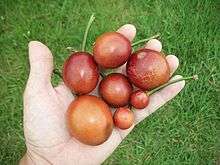Capparis tomentosa
Capparis tomentosa, the woolly caper bush[2] or African caper, is a plant in the Capparaceae family and is native to Africa.
| Capparis tomentosa | |
|---|---|
| Capparis tomentosa growing as a shrub in Amanzimtoti, South Africa | |
| Scientific classification | |
| Kingdom: | Plantae |
| Clade: | Tracheophytes |
| Clade: | Angiosperms |
| Clade: | Eudicots |
| Clade: | Rosids |
| Order: | Brassicales |
| Family: | Capparaceae |
| Genus: | Capparis |
| Species: | C. tomentosa |
| Binomial name | |
| Capparis tomentosa Lam. | |
| Synonyms | |
| |
Distribution
Found in bushveld and forest from the Eastern Cape of South Africa, through KwaZulu-Natal, Mpumalanga, Limpopo Province, Mozambique, Botswana, Namibia and into tropical Africa.[2] The northern part of the range extends from Senegal to Eritrea, and this species is also found in the Mascarene Islands.[1]
Description
Growth form
Mostly a robust woody climber;[3] which in riverine vegetation may grow to the top of the canopy.[2] It may also be a straggling shrub or small tree.[2][3]
Stem
The stem has sharp, paired, hooked spines.[3] Young stems and spines are covered in dense velvety yellow hairs.[2]
Leaves
The leaves form between the spines[2] and are alternate, oblong to broadly elliptic[3] (30-80 × 15–25 mm[2]), greyish-olive green, covered in velvet hairs (or smooth[2]); margins entire,[3] rolled under.[2] The petiole is 4–12 mm long[1] and velvety.[2]
Flowers

The flowers form in clusters; terminally on the primary branches or on short leafy lateral branchlets or occasionally scattered in the upper leaf-axils.[1] They are large (35 mm) and scented, with a mass of pinkish-white stamens[2] which are each 20–35 mm in length and may be crimson coloured at the base.[1] The sepals are boat shaped and 8–10 mm long.[1] The petals are whitish; 15–25 mm long and 7–10 mm wide.[1]
Fruit
The fruits hang from a long (25–50 mm[1]) stalk-like branch called a gynophore.[2][3] They are up to 40 mm (50 mm[1]) in diameter;[2][3] shiny green at first,[2] ripening to pink or orange.[3] The fruit contain many seeds[2] embedded in a pinkish flesh.[1] Dried-out, emptied fruit may hang on the plant for some time.[2]
Toxins
Desert sheep, zebu calves and Nubian goats were fed varying amounts of dry Capparis tomentosa leaves and died or were killed in extremis at various times after the commencement of dosing.[4][5] Signs of Capparis poisoning in the sheep and calves were; weakness of the hind limbs, staggering, swaying, flexion of the fetlock and phalangeal joints, pain in the sacral region, inappetence and recumbency.[4] There was a decrease in the level of total protein and calcium and an increase of glutamic oxaloacetic transaminase (GOT), ammonia, sodium and potassium in serum.[4] The main pathological changes were vacuolation of the neurons and axons in the spinal cord, with necrosis of the centrilobular hepatocytes and renal convoluted tubules and glomeruli.[4] In Capparis-fed goats, anaemia developed and the results of kidney and liver function tests were correlated with clinical abnormalities and pathologic changes.[5] The prominent features of toxicity were inappetence, locomotor disturbances, paresis especially of the hind limbs and recumbency.[5] Lesions comprised perineuronal vacuolation in the gray matter of the spinal cord at the sacral region, centrilobular hepatocellular necrosis, degeneration of the renal proximal convoluted and collecting tubules, serous atrophy of the cardiac fat and renal pelvis and straw-coloured fluid in serious cavities.[5] One goat which was receiving Capparis stem at 2.5 g/kg on an every other day basis for 8 days, developed signs of toxicosis, but recovered following cessation of plant administration.[5]
Isolated compounds were identified in Capparis tomentosa as 24-ethylcholestan-5-en-3-ol a phytosterol and a dipeptide derivative, N-benzoylphenylalanylaninol acetate.[6]
Human uses
This species has traditional medicinal and magical uses in Africa. Among others it is used as a remedy for diarrhea, swelling and water retention.[7] It is a decorative plant in gardens[2] and can be used for hedging; being suitable as a security barrier because of the hooked spines. The fruit may sometimes be eaten by people.[2]
Ecological significance
Several species of butterfly use this plant as a larval food plant, including; Belenois gidica, Dixeia pigea, Eronia leda and Colotis evenina.[8] Game animals browse the leaves and monkeys and bushpigs eat the fruit.[2]
References
- JSTOR Plant Science: Capparis tomentosa Lam.http://plants.jstor.org/taxon/Capparis.tomentosa, retrieved 23 August 2010.
- Pooley, E. (1993). The Complete Field Guide to Trees of Natal, Zululand and Transkei. ISBN 0-620-17697-0.
- Hyde, M.A. & Wursten, B. (2010). Flora of Zimbabwe: Species information: Capparis tomentosa. http://www.zimbabweflora.co.zw/speciesdata/species.php?species_id=124460, retrieved 6 August 2010
- Ahmed O.M., Adam S.E., Edds G.T. The toxicity of Capparis tomentosa in sheep and calves. Vet Hum Toxicol. 1981 Dec;23(6):403-9.
- Ahmed S.A., Amin A.E., Adam S.E., Hapke H.J. By toxic effects of the dried leaves and stem of Capparis tomentosa on Nubian goats. Dtsch Tierarztl Wochenschr. 1993 May;100(5):192-4.
- Akoto O., Oppong I.V. , Addae-Mensah I. , Waibel R. and Achenbach H. Isolation and characterization of dipeptide derivative and phytosterol from Capparis tomentosa Lam. Scientific Research and Essays Vol. 3 (8), pp. 355–358, August 2008.
- 1929-, Duke, James A. (2002). Handbook of medicinal herbs. Duke, James A., 1929- (2nd ed.). Boca Raton, FL: CRC Press. ISBN 0849312841. OCLC 48876592.CS1 maint: numeric names: authors list (link)
- Williams, M. (1994). Butterflies of Southern Africa; A Field Guide. ISBN 1-86812-516-5.
External links
- Dressler, S.; Schmidt, M. & Zizka, G. (2014). "Capparis tomentosa". African plants – a Photo Guide. Frankfurt/Main: Forschungsinstitut Senckenberg.